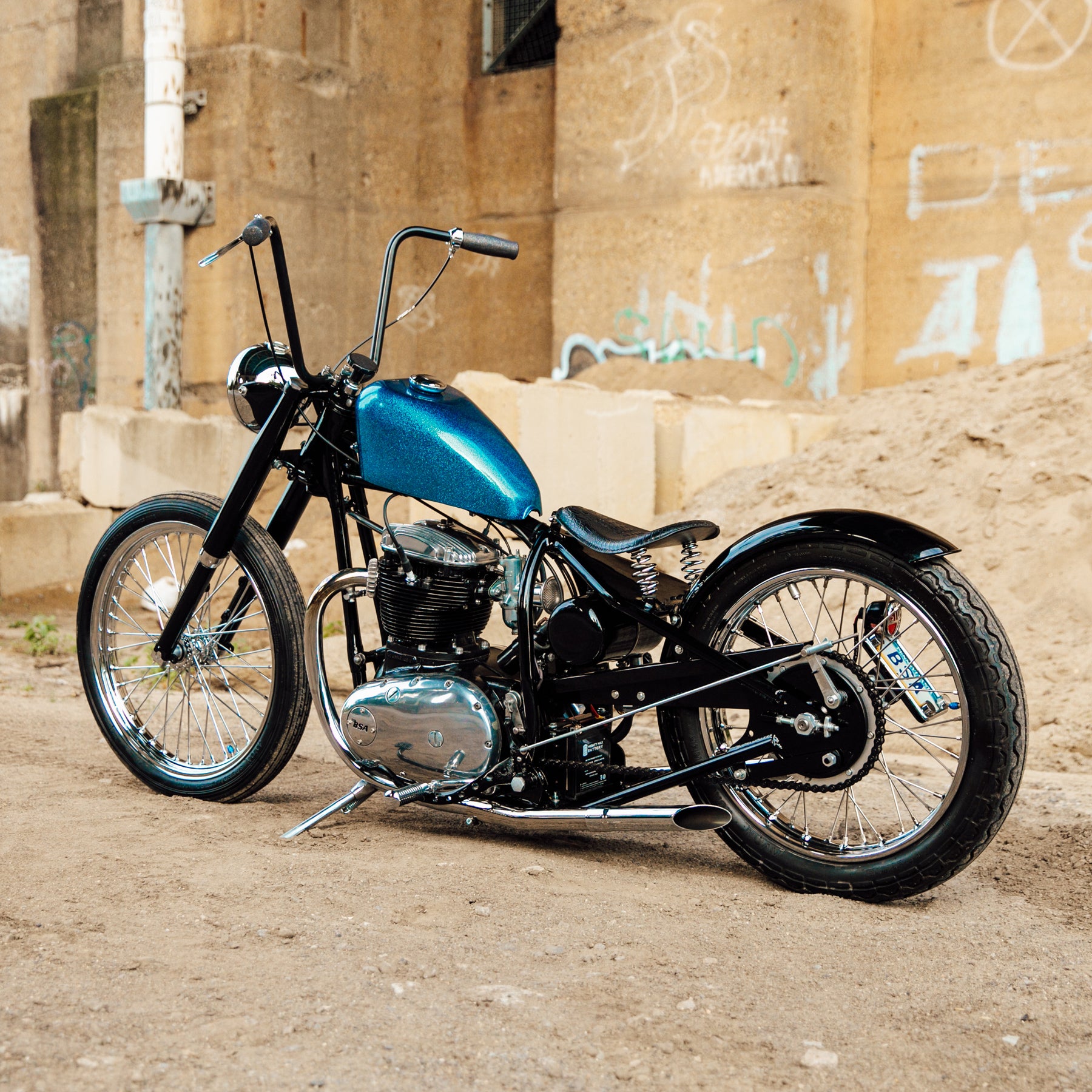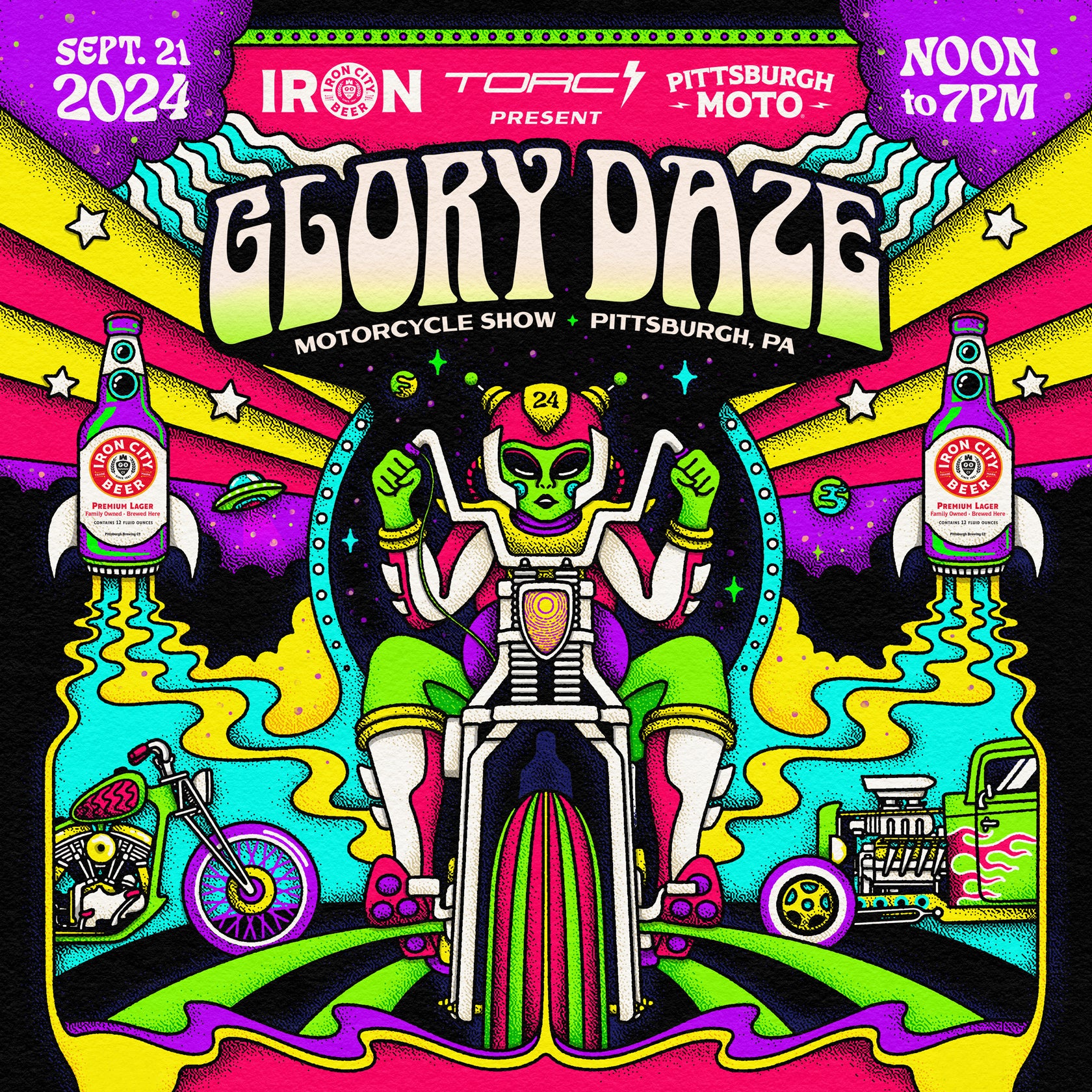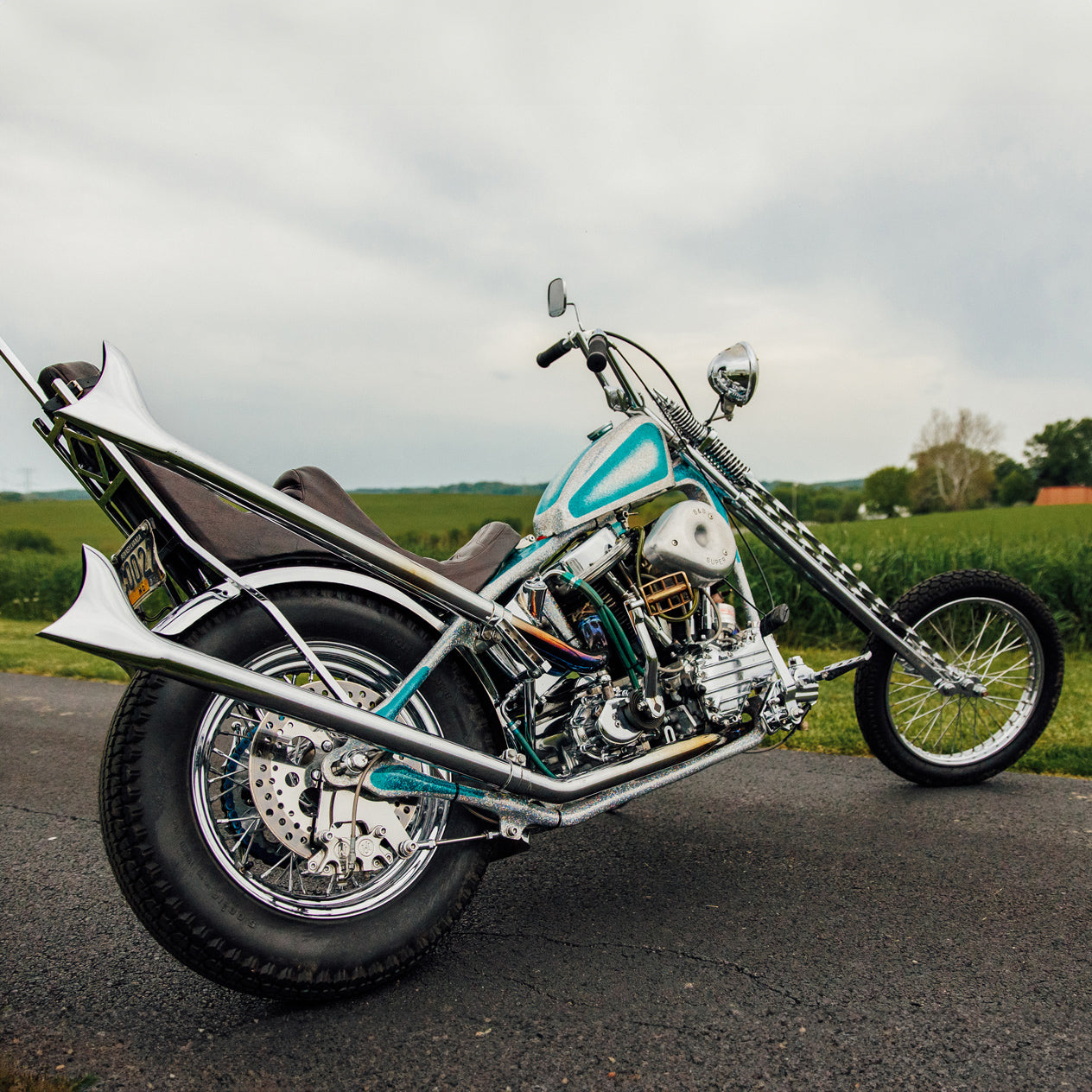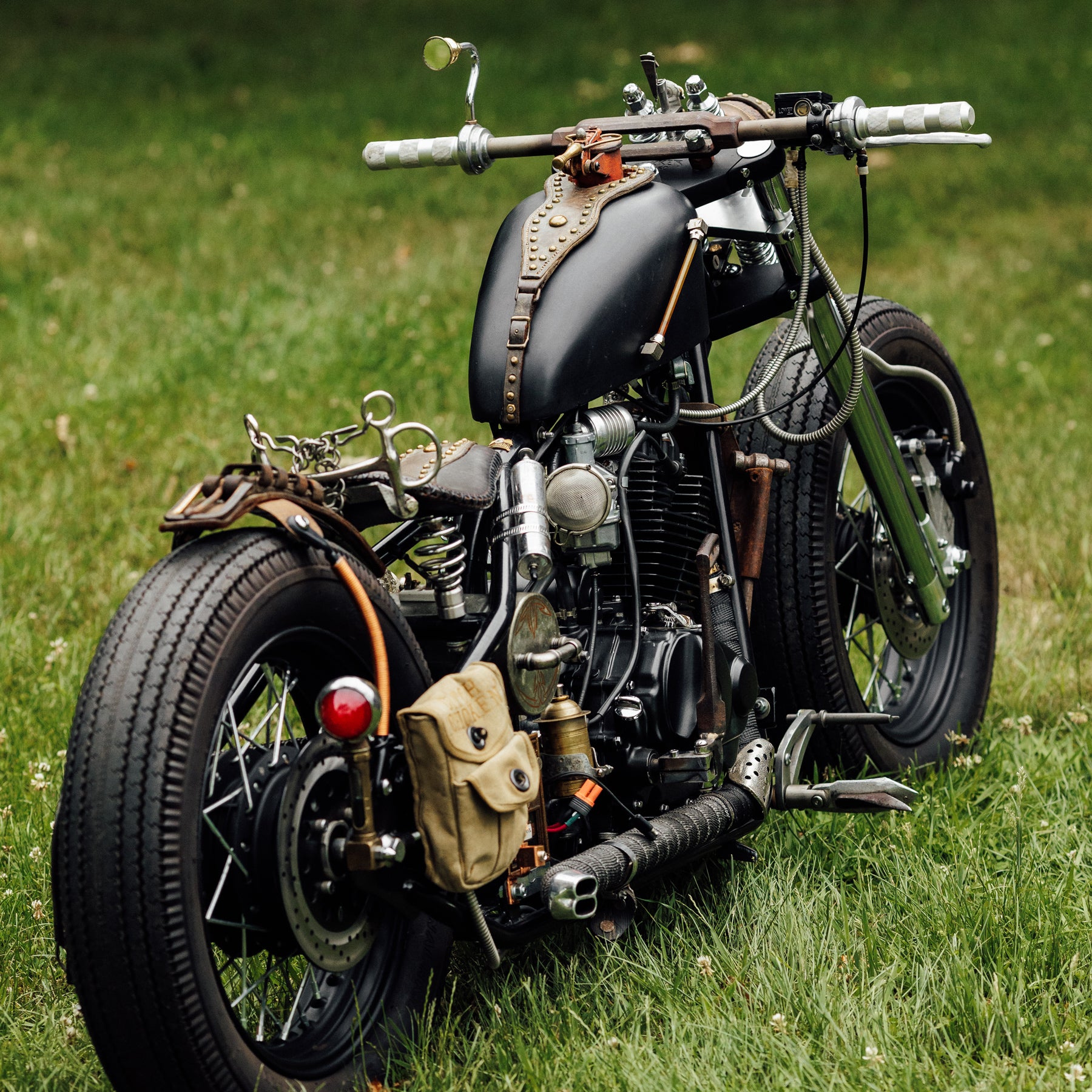

BSA Lightning Bobber
Words: Kurt Diserio - Photos: Alexa Diserio
Certain things in life are impossible to ignore. Whenever a custom-built BSA bobber is brought up, there’s a one-hundred percent chance we’re going to check it out. These intriguing motorcycles were manufactured by the Birmingham Small Arms Company in England throughout the 1900s and have always been considered classics in my lifetime. When it comes to garage-built choppers or bobbers, it’s always refreshing to see a British bike built around a platform typically reserved for American or Japanese models. What you see here is the combination of different BSA and Triumph parts and pieces, all working together as one clean, stripped-down build from Kyle Feather and his father, Randy Feather.
What’s the backstory with the bike?
Kyle Feather: I’m originally from Bedford county, and my dad has a shop there that he works out of. He’s been into British bikes for years and has a bunch of restored models and parts that he has picked up from swap meets. He built a BSA cafe racer and has a number of Triumphs that he’s been messing with forever. At one point, I suggested that we build a bobber. He mentioned using a BSA, so we started by digging up some parts to see how it could possibly come together.
What’s the backstory with the bike?
Kyle Feather: I’m originally from Bedford county, and my dad has a shop there that he works out of. He’s been into British bikes for years and has a bunch of restored models and parts that he has picked up from swap meets. He built a BSA cafe racer and has a number of Triumphs that he’s been messing with forever. At one point, I suggested that we build a bobber. He mentioned using a BSA, so we started by digging up some parts to see how it could possibly come together.

Was there something in particular that drew your father to British bikes?
KF: He likes anything but just started picking up Triumph, BSA, and even some Norton models over the years. I don’t know why British, but now they’re getting a little more scarce. There are a lot of different pieces involved with this bike.
Was there a plan when building it or did it just come to you as it progressed?
KF: A lot of the parts were stuff my dad had laying around. For instance, the frame is actually a BSA Thunderbolt with a six-inch extended hardtail welded on. We needed a good frame to work with, and the one that originally had this rear end on it was slightly twisted. We knew we had to get a new front loop, so we found the best frame and chopped the rear off of it before welding on the extended hardtail. All mounting tabs were cut off and reworked where needed. I have to give my dad, Randy, props on the welding. He’s a master welder who was a blacksmith with the railroad in Altoona.
How did the engine and front end come together?
KF: My dad had a few different engines we were considering. This one had a title, so that’s how it ended up on this bike. It was originally on a clean 1971 Lightning that we bought from a friend. We took it all the way down to port and polish the head and go through the transmission. These typically have a three-spring clutch, but this uses a four-spring racing setup. From there, it was just trial and error over and over with other parts.
The front end was especially tough. We used Triumph lowers with the original BSA setup. Surprisingly enough, even though they’re both British and similar, they were very different. The shrouds were stock BSA B44 fork shrouds coupled with stock BSA rear shock shrouds to make them long enough. They had the same diameter, so we cut pieces off of those and had them TIG welded together to cover the majority of the front end. The chrome dust covers were also from a Triumph, but we had to machine off the lip to slide the covers down over. The headlight bracket was part of the fork shrouds, but we used a larger BSA headlight. The front wheel is a TC Bros 21-inch with an Avon Roadmaster tire. The axle in this wheel is set up for a Harley, so to get around it, we had to have custom spacers and an axle made that was larger in the center and tapered down to the edges to fit the Triumph lowers.
KF: He likes anything but just started picking up Triumph, BSA, and even some Norton models over the years. I don’t know why British, but now they’re getting a little more scarce. There are a lot of different pieces involved with this bike.
Was there a plan when building it or did it just come to you as it progressed?
KF: A lot of the parts were stuff my dad had laying around. For instance, the frame is actually a BSA Thunderbolt with a six-inch extended hardtail welded on. We needed a good frame to work with, and the one that originally had this rear end on it was slightly twisted. We knew we had to get a new front loop, so we found the best frame and chopped the rear off of it before welding on the extended hardtail. All mounting tabs were cut off and reworked where needed. I have to give my dad, Randy, props on the welding. He’s a master welder who was a blacksmith with the railroad in Altoona.
How did the engine and front end come together?
KF: My dad had a few different engines we were considering. This one had a title, so that’s how it ended up on this bike. It was originally on a clean 1971 Lightning that we bought from a friend. We took it all the way down to port and polish the head and go through the transmission. These typically have a three-spring clutch, but this uses a four-spring racing setup. From there, it was just trial and error over and over with other parts.
The front end was especially tough. We used Triumph lowers with the original BSA setup. Surprisingly enough, even though they’re both British and similar, they were very different. The shrouds were stock BSA B44 fork shrouds coupled with stock BSA rear shock shrouds to make them long enough. They had the same diameter, so we cut pieces off of those and had them TIG welded together to cover the majority of the front end. The chrome dust covers were also from a Triumph, but we had to machine off the lip to slide the covers down over. The headlight bracket was part of the fork shrouds, but we used a larger BSA headlight. The front wheel is a TC Bros 21-inch with an Avon Roadmaster tire. The axle in this wheel is set up for a Harley, so to get around it, we had to have custom spacers and an axle made that was larger in the center and tapered down to the edges to fit the Triumph lowers.

Compared to other bikes, what differences stand out with the BSA?
KF: The shifter is on the right side and foot brake on the left. Compared to my Triumph, there’s not a lot of difference. They ride and sound similar, both parallel twins.
What other pieces did you want to point out?
KF: There’s a 19-inch wheel we laced to a Triumph hub on the rear. It sat super low with the extended rear end, so the larger wheel kept it up a little more. We were deciding between the BSA style star hub and the Triumph hub, but I liked the spool look. Some Triumph models actually had the 19-inch wheels on both the front and rear.
The fuel tank is from a Harley Sportster and was painted by my dad’s friend, Dave Shumaker. We were looking at the round BSA tanks, but they stuck out on the sides and I wanted to go slimmer.
As far as the rest of the bike, it’s a single carburetor head, which was something we changed over and not typical on a Lightning. My dad hand made the chain guard. The rear fender is a Norton front fender that we cut down. The mounting brackets on the rear fender were modified to eliminate the braces, giving it a cleaner look.
Did you have trouble finding parts for it, and when did you get it finished?
KF: We didn’t have too much trouble finding parts for the bike. The front end was a lot of trial and error. We thought we were going to go with the open exposed spring look at first but liked the look of the shrouds. We started on it in September 2018 and worked on and off when I could get out there to help out. Realistically, we finished it around March 2020. Some days we would just be standing there looking at it in the garage, not knowing where to go with it. It was something that we would work on, then put aside and come back to later.
KF: The shifter is on the right side and foot brake on the left. Compared to my Triumph, there’s not a lot of difference. They ride and sound similar, both parallel twins.
What other pieces did you want to point out?
KF: There’s a 19-inch wheel we laced to a Triumph hub on the rear. It sat super low with the extended rear end, so the larger wheel kept it up a little more. We were deciding between the BSA style star hub and the Triumph hub, but I liked the spool look. Some Triumph models actually had the 19-inch wheels on both the front and rear.
The fuel tank is from a Harley Sportster and was painted by my dad’s friend, Dave Shumaker. We were looking at the round BSA tanks, but they stuck out on the sides and I wanted to go slimmer.
As far as the rest of the bike, it’s a single carburetor head, which was something we changed over and not typical on a Lightning. My dad hand made the chain guard. The rear fender is a Norton front fender that we cut down. The mounting brackets on the rear fender were modified to eliminate the braces, giving it a cleaner look.
Did you have trouble finding parts for it, and when did you get it finished?
KF: We didn’t have too much trouble finding parts for the bike. The front end was a lot of trial and error. We thought we were going to go with the open exposed spring look at first but liked the look of the shrouds. We started on it in September 2018 and worked on and off when I could get out there to help out. Realistically, we finished it around March 2020. Some days we would just be standing there looking at it in the garage, not knowing where to go with it. It was something that we would work on, then put aside and come back to later.
















